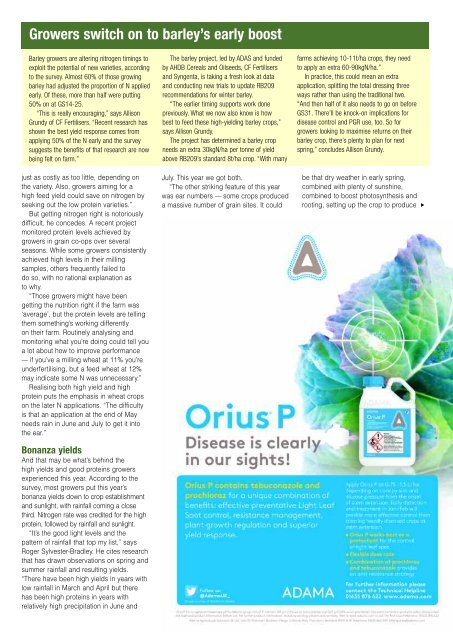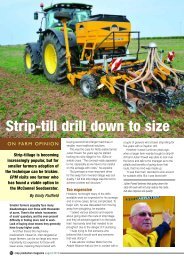Create successful ePaper yourself
Turn your PDF publications into a flip-book with our unique Google optimized e-Paper software.
Growers switch on to barley’s early boost<br />
Barley growers are altering nitrogen timings to<br />
exploit the potential of new varieties, according<br />
to the survey. Almost 60% of those growing<br />
barley had adjusted the proportion of N applied<br />
early. Of these, more than half were putting<br />
50% on at GS14-25.<br />
“This is really encouraging,” says Allison<br />
Grundy of CF Fertilisers. “Recent research has<br />
shown the best yield response comes from<br />
applying 50% of the N early and the survey<br />
suggests the benefits of that research are now<br />
being felt on farm.”<br />
just as costly as too little, depending on<br />
the variety. Also, growers aiming for a<br />
high feed yield could save on nitrogen by<br />
seeking out the low protein varieties.”<br />
But getting nitrogen right is notoriously<br />
difficult, he concedes. A recent project<br />
monitored protein levels achieved by<br />
growers in grain co-ops over several<br />
seasons. While some growers consistently<br />
achieved high levels in their milling<br />
samples, others frequently failed to<br />
do so, with no rational explanation as<br />
to why.<br />
“Those growers might have been<br />
getting the nutrition right if the farm was<br />
‘average’, but the protein levels are telling<br />
them something’s working differently<br />
on their farm. Routinely analysing and<br />
monitoring what you’re doing could tell you<br />
a lot about how to improve performance<br />
–– if you’ve a milling wheat at 11% you’re<br />
underfertilising, but a feed wheat at 12%<br />
may indicate some N was unnecessary.”<br />
Realising both high yield and high<br />
protein puts the emphasis in wheat crops<br />
on the later N applications. “The difficulty<br />
is that an application at the end of May<br />
needs rain in June and July to get it into<br />
the ear.”<br />
Bonanza yields<br />
And that may be what’s behind the<br />
high yields and good proteins growers<br />
experienced <strong>this</strong> year. According to the<br />
survey, most growers put <strong>this</strong> year’s<br />
bonanza yields down to crop establishment<br />
and sunlight, with rainfall coming a close<br />
third. Nitrogen rate was credited for the high<br />
protein, followed by rainfall and sunlight.<br />
“It’s the good light levels and the<br />
pattern of rainfall that top my list,” says<br />
Roger Sylvester-Bradley. He cites research<br />
that has drawn observations on spring and<br />
summer rainfall and resulting yields.<br />
“There have been high yields in years with<br />
low rainfall in March and April but there<br />
has been high proteins in years with<br />
relatively high precipitation in June and<br />
The barley project, led by ADAS and funded<br />
by AHDB Cereals and Oilseeds, CF Fertilisers<br />
and Syngenta, is taking a fresh look at data<br />
and conducting new trials to update RB209<br />
recommendations for winter barley.<br />
“The earlier timing supports work done<br />
previously. What we now also know is how<br />
best to feed these high-yielding barley crops,”<br />
says Allison Grundy.<br />
The project has determined a barley crop<br />
needs an extra 30kgN/ha per tonne of yield<br />
above RB209’s standard 8t/ha crop. “With many<br />
July. This year we got both.<br />
“The other striking feature of <strong>this</strong> year<br />
was ear numbers –– some crops produced<br />
a massive number of grain sites. It could<br />
farms achieving 10-11t/ha crops, they need<br />
to apply an extra 60-90kgN/ha.”<br />
<strong>In</strong> practice, <strong>this</strong> could mean an extra<br />
application, splitting the total dressing three<br />
ways rather than using the traditional two.<br />
“And then half of it also needs to go on before<br />
GS31. There’ll be knock-on implications for<br />
disease control and PGR use, too. So for<br />
growers looking to maximise returns on their<br />
barley crop, there’s plenty to plan for next<br />
spring,” concludes Allison Grundy.<br />
be that dry weather in early spring,<br />
combined with plenty of sunshine,<br />
combined to boost photosynthesis and<br />
rooting, setting up the crop to produce<br />
▲



